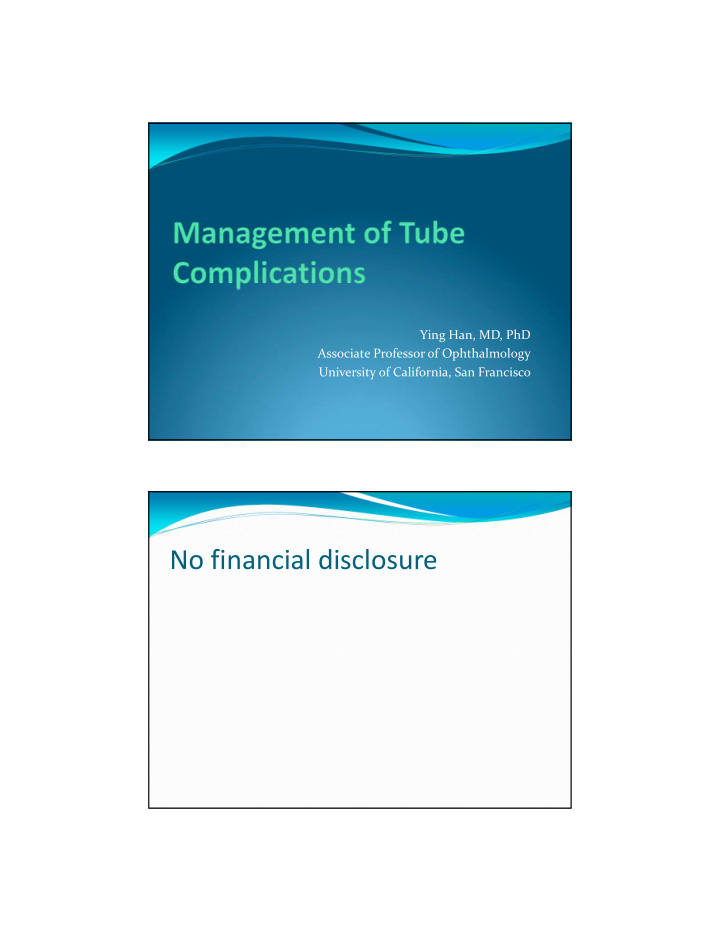



Ying Han, MD, PhD Associate Professor of Ophthalmology University of California, San Francisco No financial disclosure
How do they work? Silicone tube to equatorial plate IOP reduction is a function of plate surface area Larger plate=lower IOP 350 mm 2 is likely the limit Thickness of plate capsule Plate material (polypropylene more inflammatory) Heuer, et al 1992, Lloyd et al, 1994 Types of Tube shunt implants Non ‐ valved tube shunt: Valved tube shunt: Baerveldt Ahmed valve Molteno tube shunt
Indications Refractory glaucoma: Neovascular glaucoma Uveitic glaucoma Pediatric glaucoma (failed angle surgery) Failure of trabeculectomy Iridocorneal Endothelial Syndrome (ICE) Eyes with prior extensive conjunctival surgery CL wear, meibomitis, personal hygiene issues Complications Corneal failure Tube erosion/extrusion Hypotony Hypertensive phase/high rate of long ‐ term failure Avoid complications for secondary glaucoma
How to avoid corneal complication • Angle of the tube relative to the cornea • Tube length in the anterior chamber from the point of insertion to the tip • Distance between the tip of the tube and cornea Koo, et al 2014
Regression analyses of tube parameters to predict endothelial cells loss Koo, et al 2014 Consideration The best tube position is inserted parallel to iris If a tube is placed pointing to cornea, the tube needs to be short Consider cataract surgery to create more anterior chamber space Consider sulcus placement in aphakic or pseudophakic eye Bevel down instead of bevel up to avoid iris to plug tube
Ahmed valve surgery with Sulcus insertion How to treat tube erosion/exposure
How to treat tube erosion Directly cover with tutoplast (donner sclera) or cornea tissue When there is no kink of the tube Redirect tube into sulcus Recurrent tube exposure Pseudophakic patient Avoid kink of tube and pressure from eyelid Redirect tube into vitreous cavity Recurrent tube exposure Require vitrectomy Tube exposure/erosion Cover with Tutoplast/corneal tissue Make sure there is no kink of the tube, otherwise it could erode again in 1 ‐ 2 years
Tube exposure/erosion Reposition tube into sulcus Tube exposure/erosion Reposition tube into vitreous cavity
How to treat hypotony Hypotony Insert Prolene suture into the lumen of tube
How to avoid hypertensive phase and improve long term IOP control Current Regimen Intraoperative injection of MMC (0.4 mg/ml) for 0.1ml Postoperative injection of MMC at POW#1 and POM#1: 0.4 mg/ml for 0.1ml. Injections are held if IOP <5 choroidal detachment shallow or flat anterior chamber Timing of injection is critical – before dense capsule formation
How to avoid complications from treating secondary glaucoma Secondary glaucoma Uveitic glaucoma Control underlying inflammation Non ‐ infectious uveitis: large dose of intra ‐ and post ‐ operative steroid Infectious uveitis: regular dose of postoperative steroid Neovascular glaucoma Preoperative anti ‐ VEGF Consider Micropulse TCP or ECP plus
Eye pressure in the fellow eye Problems Elevated eye pressure during immediate postoperative period time, especially for uveitic glaucoma patients who is sensitive to steroid Jiang et al.
Summary Insert the tube posteriorly and parallel to iris Early use of aqueous suppression Consider intra ‐ and post ‐ operative use of antifibrotic agents For secondary glaucoma: Treat underline diseases Consider other treatments: micropulse TCP, ECP, ECP plus, TCP Thank you !
Recommend
More recommend